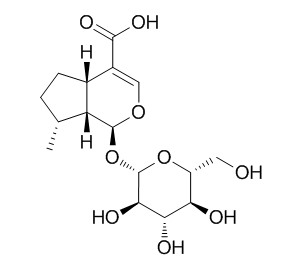8-Epideoxyloganic acid
8-Epideoxyloganic acid possesses bioactivities of analgesia, homeostasis and anti-inflammatory. It has the potential to serve as anti-inflammatory agents during oxidative stress, the inhibition of ROS production, possibly through modulation of NOX activity and/or the radical scavenging effect, and beta2 integrin expression in leucocytes. 8-Epideoxyloganic acid (oral) shows weak antinociceptive activity.
Inquire / Order:
manager@chemfaces.com
Technical Inquiries:
service@chemfaces.com
Tel:
+86-27-84237783
Fax:
+86-27-84254680
Address:
1 Building, No. 83, CheCheng Rd., Wuhan Economic and Technological Development Zone, Wuhan, Hubei 430056, PRC
Providing storage is as stated on the product vial and the vial is kept tightly sealed, the product can be stored for up to
24 months(2-8C).
Wherever possible, you should prepare and use solutions on the same day. However, if you need to make up stock solutions in advance, we recommend that you store the solution as aliquots in tightly sealed vials at -20C. Generally, these will be useable for up to two weeks. Before use, and prior to opening the vial we recommend that you allow your product to equilibrate to room temperature for at least 1 hour.
Need more advice on solubility, usage and handling? Please email to: service@chemfaces.com
The packaging of the product may have turned upside down during transportation, resulting in the natural compounds adhering to the neck or cap of the vial. take the vial out of its packaging and gently shake to let the compounds fall to the bottom of the vial. for liquid products, centrifuge at 200-500 RPM to gather the liquid at the bottom of the vial. try to avoid loss or contamination during handling.
Int J Food Sci Nutr.2019, 70(7):825-833
Phytomedicine.2019, 55:229-237
Heliyon.2024, 10(7):e28755.
Natural Product Communications2020, doi: 10.1177.
Molecules.2020, 25(21):5091.
Environ Toxicol.2023, 38(5):1174-1184.
Molecules.2024, 29(5):1048.
Mol Cell.2017, 68(4):673-685
Cell J.2024, 26(8):496-504.
Biochem Biophys Res Commun.2020, 527(4):889-895.
Related and Featured Products
J Pharm Pharmacol. 2006 Jan;58(1):129-35.
The inhibitory effect of phenylpropanoid glycosides and iridoid glucosides on free radical production and beta2 integrin expression in human leucocytes.[Pubmed:
16393473 ]
Rapid production of reactive oxygen species (ROS) and upregulation of beta2 integrin by leucocytes are two important inflammatory responses in human leucocytes.
METHODS AND RESULTS:
To evaluate whether three phenylpropanoid glycosides (acteoside, crenatoside, and rossicaside B) and two iridoid glucosides (boschnaloside and 8-Epideoxyloganic acid) identified from two medicinal plants with similar indications (Orobanche caerulescens and Boschniakia rossica) exhibited anti-inflammatory activity, their effects on N-formyl-methionyl-leucyl-phenylalanine (fMLP) and phorbol-12-myristate-13-acetate (PMA)-activated peripheral human neutrophils (PMNs) and mononuclear cells were examined. Furthermore, all compounds, except rossicaside B, significantly inhibited PMA- and fMLP-induced Mac-1 (a beta2 integrin) upregulation at 50 microM but not that of fMLP-induced intracellular calcium mobilization. These drugs had no significant cytotoxicity as compared with the vehicle control.
CONCLUSIONS:
Our data suggested that inhibition of ROS production, possibly through modulation of NOX activity and/or the radical scavenging effect, and beta2 integrin expression in leucocytes indicated that these compounds had the potential to serve as anti-inflammatory agents during oxidative stress.
Phytochemistry. 2000 Jan;53(2):253-6.
Antinociceptive substances from Incarvillea delavayi.[Pubmed:
10680179]
Antinociceptive activities of an Incarvillea delavayi extract, as well as its constituents, 8-Epideoxyloganic acid and delavayine A, were evaluated in the acetic acid induced writhing test in mice.
METHODS AND RESULTS:
An oral administration of the delavayi extract weakly decreased the number of writhings and stretchings in this test, in a dose-dependent manner. Furthermore, orally administered 8-Epideoxyloganic acid showed weak antinociceptive activity, whereas administration by subcutaneous injection did not. However, subcutaneous injection of delavayine A, a novel monoterpene alkaloid, showed a more significant level of antinociceptive activity.
Zhongguo Zhong Yao Za Zhi. 2011 Feb;36(4):465-7.
Constituents and bioactivities of Lamiophlomis rotata.[Pubmed:
21598543]
To investigate the chemical constituents from Lamiophlomis rotata and the bioactivities of 8-Epideoxyloganic acid.
METHODS AND RESULTS:
The constituents were isolated by using a combination of various chromatographic techniques including column chromatography over ployamide, silica gel and Sephadex LH-20. Structures of the isolates were identified by spectroscopic data analysis. Bioactivities were screened by using models in vivo. Five constituents were isolated. 8-Epideoxyloganic acid was isolated for the first time in L. rotata and also in lamioplomis genus.
8-Epideoxyloganic acid could significantly inhibit aectic acid-induced twisting times and slower the time of homeostatsis, also inhibit xylene-induced ear edema in mice.
CONCLUSIONS:
8-Epideoxyloganic acid possesses bioactivities of analgesia, homeostasis and anti-inflammatory.



